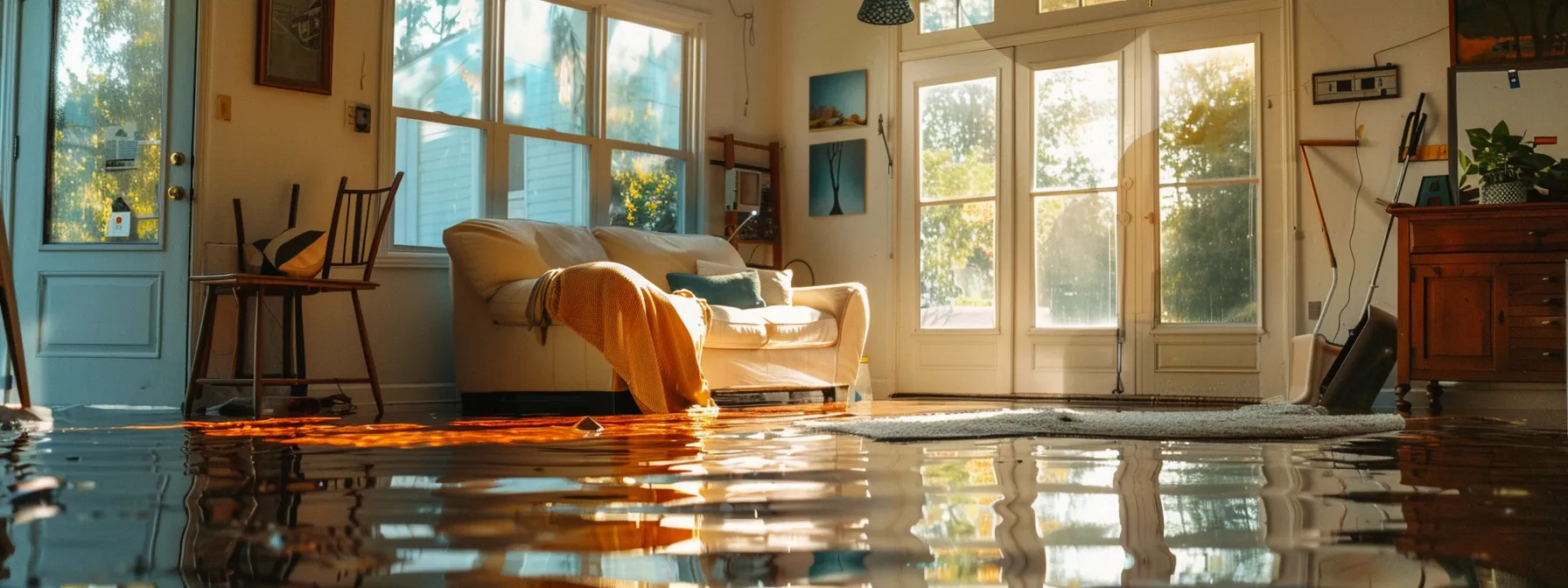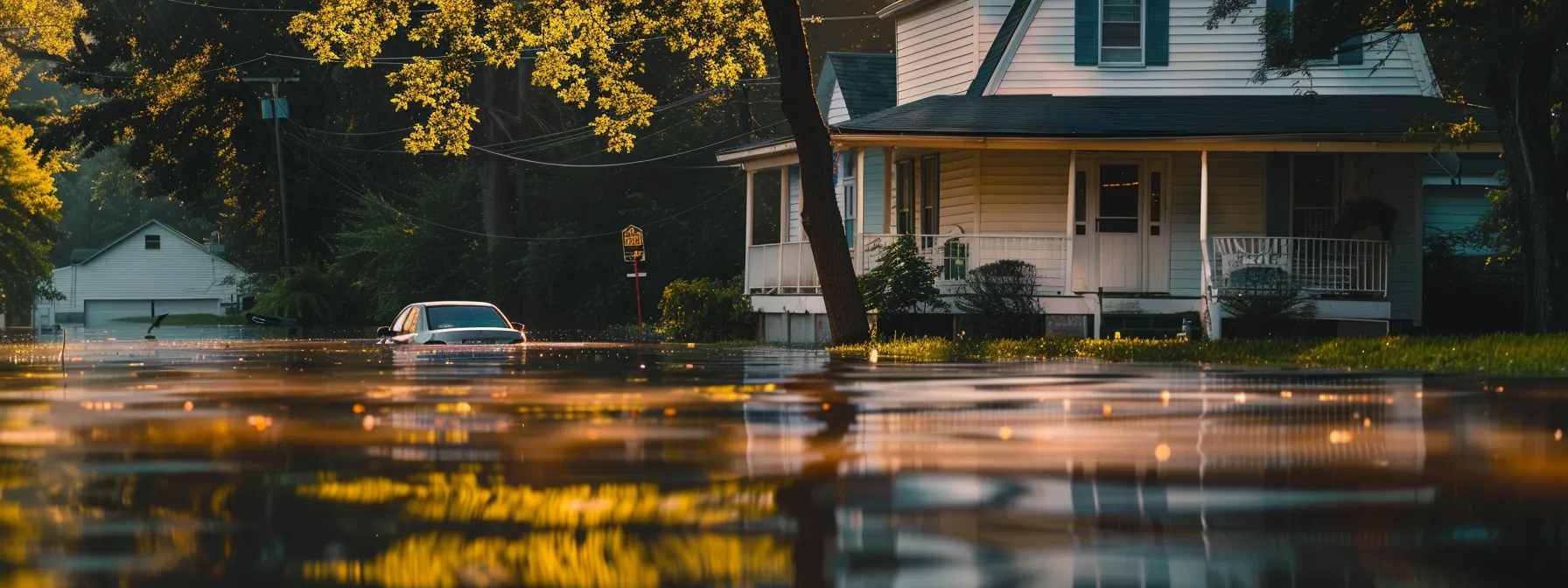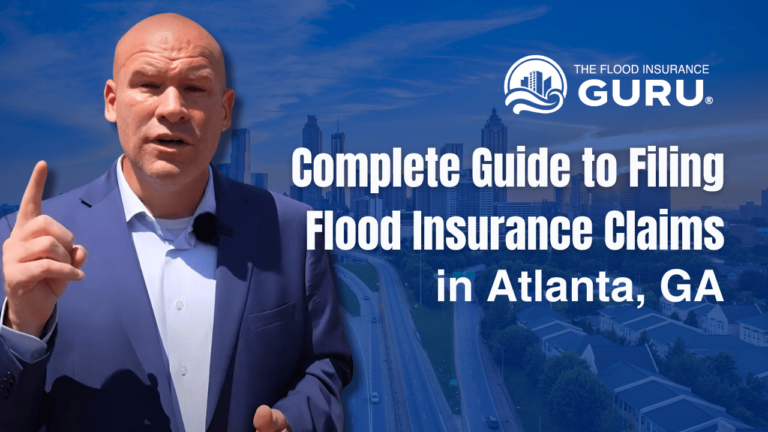Your Guide to Secure Flood Insurance Online Quotes
Securing the right flood insurance policy is as crucial as wearing a helmet to safeguard against an injury. It requires the same diligence and awareness you employ when choosing a vehicle or home insurance.
Just as you wouldn’t drive without insurance to protect against unforeseen mishaps, you can’t afford to overlook flood insurance in a world where extreme weather events are becoming more common.
In this article, you’ll find a comprehensive breakdown of obtaining online quotes for flood insurance, weaving through complexities with ease and ensuring you have the coverage that best suits your needs. Let’s take the next step together toward a more secure and well-prepared household.
HOW TO START YOUR FLOOD INSURANCE QUOTE ONLINE
Embarking on the journey to secure a flood insurance quote online mirrors the process of obtaining other types of policies, such as pet insurance, life insurance, or liability insurance.
My initial step typically involves scouting for credible insurance websites that specialize in this domain. I know when I was buying a home in a flood zone AE that required flood insurance that this was a challenge that i faced. Once there, I meticulously input my property’s specifics, ensuring all details are accurate to receive a tailored quote.
Grasping the various coverage options available allows me to discern which policy matches my needs, much like selecting the right credit card that aligns with my spending habits—each has its unique benefits and limitations. Before proceeding, I gather all necessary documentation to streamline the process, thus paving the way for a quicker, more efficient transaction.

Visit Trusted Insurance Websites
In my first steps towards obtaining flood insurance, I focus on visiting websites that have a reputation for trustworthiness and specialize in flood coverage. Inputting my zip code usually directs me to policies pertinent to my region, ensuring the quotes I receive are as relevant as possible to the flood risk in my area.
These sites often provide insights into varying deductible options, which can significantly affect my out-of-pocket costs in the event of a flood-related accident. avoiding mistakes a guide to buying flood insurance. Its important to know that flood insurance deductibles typically have less of an impact on insurance premiums than other insurance products.
It’s analogous to researching vehicle insurance; you must ensure the policy covers all potential incidents and that the provider is recognized for their reliability. I’m careful to choose a site that not only assists in securing comprehensive flood coverage but also maintains a straightforward claims process. This attentive selection is the linchpin for safeguarding my property while maintaining my peace of mind.
Input Your Property Information
Entering my property details is a critical step that mirrors the process required when I tackle motorcycle or personal injury insurance: thorough and precise. I meticulously input accurate data about my property, focusing on its size, location, and any unique features or risks that might influence the assessment of flood risk and the subsequent insurance pricing. An oversight in this stage can lead to discrepancies that may affect not just the quotes, but also my degree of protection against potential property damage.
|
Property Feature |
Details Provided |
Impact on Quote |
|
Size |
Exact square footage |
Influence on cost |
|
Location |
Address and proximity to water bodies |
Assessment of flood risk |
|
Risk Factors |
Previous claims, flood history |
Insurance pricing adjustment |
As I transition to the next step, which is similar to fine-tuning a property insurance plan, I review the details I’ve entered. This is my safeguard to ensure that the quote reflects a level of coverage appropriate for my home’s value and my tolerance for risk. An insightful assessment at this juncture allows me to defend my property against instances of flooding, just as I would protect against damages in the event of a motorcycle accident under a personalized insurance policy.
Understand Coverage Options
Just as with term life insurance or health insurance, understanding the nuances of flood insurance coverage is key to making an informed decision. Each policy comes with coverage limits, exclusions, and conditions that can affect my overall payment obligations and the support I receive following a flood event. Thoroughly reviewing these details ensures that I’m considering the long-term value of the policy I choose, rather than just the upfront cost.
Assessing the options carefully, I liken the process to weighing the terms of a loan or deciding on a credit card – each choice has its financial implications. A policy that offers lower premiums might resemble an attractive loan offer, but it’s essential to look beyond the initial savings and understand what’s covered. Is the foundation of my home included? What about the personal items within? This information is critical as it directly impacts my financial commitment and security.
|
Coverage Aspect |
Consideration |
|
Premiums |
Immediate payment requirements |
|
Exclusions |
Potential out-of-pocket expenses |
|
Policy Limits |
Financial protection extent |
Prepare Your Documentation
To mitigate any delays in receiving a flood insurance quote, I gather all pertinent documentation in advance. Collecting evidence of past damages, proof of homeownership, and any specifics pertaining to the community’s flood zone category expedites the process. Prior loss history on a property could impact your national flood insurance program quote and even disqualify you for certain private companies. It could also stop future claims from being paid if the previous damage was not repaired. This is exactly what happened to a new home buyer in Florida. This is akin to preparing for a condominium association meeting – readiness is key, and having your documents at hand ensures a smooth course of action.
Many insurance providers now offer a mobile app, making the submission of documents as breezy as a day sailing on your boat. I take full advantage of these technological conveniences, uploading pictures of my home and any supporting documents directly through the app. Before doing so, I often consult the provider’s FAQ section to confirm the types of documentation required and to understand the provider’s standard procedure for claims involving flood damage.
|
Document Type |
Details |
Purpose |
|
Proof of Ownership |
Deed or mortgage statement |
Verification of ownership |
|
Past Damage Reports |
Claims and repair records |
Evidence of property condition |
|
Flood Zone Information |
Official flood maps, community zone |
Risk assessment |
UNDERSTANDING THE TYPES OF FLOOD INSURANCE COVERAGE
Securing a comprehensive flood insurance policy online can be likened to crafting a protective shield, much as personal injury protection layers a mantle of security over us when we traverse the road. In my endeavors to ensure my property is robustly safeguarded against the devastations of flooding, I’ve learned the essentiality of discerning the various aspects of coverage available.
We must know what Building Property Coverage entails—these are the fundamentals, the brick and mortar of our peace of mind. Then there’s the crucial Contents Coverage, akin to the roadside assistance that comes to our rescue; it’s the assurance that our valued possessions are protected. I consider the provision for Additional Living Expenses Coverage, for it is not just about the walls that surround us, but the liberty to maintain our lifestyle during repairs.

Further, I weigh the merits of Replacement Cost Policies against Actual Cash Value Policies, casting a critical eye over each, much as when scrutinizing the fine details of a license. Weighing these options is not a mere financial exercise but a commitment to guarding the sanctity and security of our homes.
Knowing What’s Covered by Building Property Coverage
As I delved into the intricacies of Building Property Coverage, I realized it’s the cornerstone of general insurance for homeowners akin to the framework of a sturdy trailer.
When reviewing my flood insurance quote, I confirmed that this section of my policy shielded the physical structure of my home, akin to the way car insurance coverage protects my vehicle on the road. Securing this component of coverage was non-negotiable as it meant ensuring the foundation, walls, and roof were financially safeguarded against flood damage. Since my mortgage required flood insurance building coverage was also a requirement for my loan to go through.
Distilling the essence of homeowners insurance, I appreciated that the Building Property Coverage extended beyond the surface, covering the intrinsic electrical and plumbing systems of my abode. Scouring through my insurance quote, I was vigilant in ensuring these critical systems were included. This coverage attested to the security I sought, reminiscent of the comprehensive protection one seeks when opting for general insurance in other spheres of possessions and valuables.
Contents Coverage: Protect Your Belongings
Just as I review a saved quote for auto insurance to ensure it covers every possible risk, I engage in a similar practice with my flood insurance’s Contents Coverage. This coverage is pivotal for homeowners like myself, safeguarding the valuables within our homes. It’s crucial to hold discussions with an insurance agent to make certain that the personal property, from electronics to furniture, is equally protected alongside the structure itself.
Every time I compare car insurance options, the attention to detail in selecting the right coverage parallels my approach to flood insurance. Contents Coverage, specifically, is where I focus on the particulars, pursuing a policy that comprehensively shields my belongings. This careful scrutiny underscores my commitment to not merely insure my home’s shell, but to also secure the assets that make it a home.
Additional Living Expenses Coverage
The component of Additional Living Expenses Coverage becomes a beacon of relief akin to the liability section in a car insurance quote. When the unthinkable occurs, and my home is uninhabitable due to flooding, this coverage steps in, covering the costs of temporary housing and living expenses that accrue while my home is being repaired.
|
Expense Type |
Details Covered |
|
Temporary Housing |
Cost for apartment, hotel, or other rental |
|
Daily Living |
Food, transportation, and basic necessities |
|
Additional Costs |
Pet boarding, storage fees, and extra commuting costs |
Consulting various insurance companies, I came to realize how this coverage is not unlike the indispensable auto insurance quote that details potential car insurance discounts. It’s an essential facet of my flood insurance policy, ensuring I’m not financially overwhelmed by unexpected expenses, just as I seek to mitigate excess costs in vehicle coverage. We had a customer at The Flood Insurance Guru who was able to get a hotel paid for up to 12 months when her Papillion Nebraska lake home was damaged by flood waters in 2018.

Replacement Cost vs. Actual Cash Value Policies
When reviewing my homeowners insurance quote, I’m often confronted with a choice between Replacement Cost policies and Actual Cash Value coverage. Replacement Cost ensures that if my property is damaged, the insurance agency will cover the cost of replacing it with new items of similar kind and quality, irrespective of depreciation. This type of coverage echoes the comprehensive nature of general insurance policies, where the aim is to restore rather than just compensate.
On the other hand, Actual Cash Value takes into account the age and condition of my belongings, much like certain auto insurance coverages factor in depreciation. This means that the insurance agency will reimburse me based on the current value of the items, not necessarily the amount it would cost to buy everything new. It’s a more economically scaled-back option, often resulting in lower premiums and a reduction in the payout when a claim is filed. I remember speaking to property owners in Houston Texas a few years ago.
She could not figure out why her flood insurance claim check was $15,000 when her policy was for $150,000. When doing a flood insurance policy review it was discovered that she had an actual cash value policy and not a replacement cost policy.
ESSENTIAL FACTORS THAT INFLUENCE YOUR FLOOD INSURANCE QUOTE
As I delve deeper into understanding the intricacies of obtaining an online flood insurance quote, several pivotal factors emerge that are just as crucial as the specifics of a life insurance policy. The exact insurance rate hinges on a detailed assessment of my location’s flood risk, similar to how an underwriter evaluates my health history when setting a life insurance premium.
No less significant are the structural specifics and features of my home, as they can either mitigate risk or heighten it, directly influencing the rate quote I receive. Additionally, similar to how a spotty driving record can affect my auto insurance costs, any previous flood claims I’ve made cast a long shadow on the current quote, potentially altering my perceived level of risk.
Ultimately, each of these factors plays a defining role in shaping the security and financial viability of the flood insurance provisions tailored to my home.
Location and Flood Risk Assessment
When seeking a flood insurance quote, I am acutely aware that my location plays a prominent role, just as the zip code influences premium calculations for a customer’s vehicle coverage. The proximity of my home to high-risk flood areas can be as crucial to insurers as a vehicle identification number is to auto insurers assessing the risk of theft for a classic car. This key piece of information can dictate not only my eligibility but also the potential cost of my policy, a cost that may impact my mortgage requirements.
Flood risk assessment is as significant to my property as a background check is to a new hire. If I’ve had prior incidents of flooding, much like claims of theft on a classic car, insurers view my home as carrying a higher risk and adjust my rates accordingly. This evaluation can be as decisive in the world of flood insurance as knowing the vehicle identification number is in settling claims after an incident. It’s vital for me to understand how these elements might influence the terms of my policy and consequently my financial responsibilities.
Your Home’s Construction and Features
The materials and design of my home play a significant role in determining my flood insurance rates, much like choosing an appropriate vehicle option influences my car lease terms. Architectural factors such as the elevation of the building, the type of foundation, and even the materials used for construction can all sway the company’s assessment of how prone my home is to flood damage and how resilient it would be in the event of such a disaster.
Mindful of this, I view the selection of robust building features as an investment in my property’s well-being and, simultaneously, as a strategic move to possibly lower my insurance premiums. Keeping my budget in consideration, I aim to strike a balance between making my house more resistant to potential flood damage and managing the ongoing costs associated with my flood insurance policy.
|
Building Feature |
Impact on Flood Risk |
Effect on Insurance Rate |
|
Elevation |
Higher elevation reduces risk |
May lower premiums |
|
Foundation Type |
Specific types may resist floodwater |
Could qualify for discounts |
|
Construction Materials |
Water-resistant materials offer better protection |
Might decrease insurance costs |
Previous Flood Claims History
My history with previous flood claims is akin to swiping a debit card during a transaction; it leaves a digital trail that insurers examine meticulously. This claims history is an integral component used in underwriting my policy, directly affecting the price I’ll pay for my flood insurance. Just as a bank reviews my financial transactions, the insurance company studies my claims history to gauge my risk factor and determine my rates. For more insights on how claims history can impact your flood insurance, visit how to find flood loss history.
|
Flood Claim Factor |
Customer Service Impact |
Underwriting Consideration |
Influence on Price |
|
Past flood claims |
May necessitate additional support |
Essential for risk assessment |
Can increase premium costs |
|
Frequency of claims |
Reflects need for robust coverage discussion |
Affects risk profile |
Critical in price calculation |
When discussing these details with customer service, I present them with the complete picture, sharing all relevant incidents, not unlike a travel itinerary when planning a journey to Mexico. Clarity and openness about my claims history assist the underwriting process, ensuring the quote I receive is both fair and reflective of my actual circumstances. This transparent approach helps build trust and shapes the price framework of the flood insurance tailored to my property’s needs.
COMPARING FLOOD INSURANCE QUOTES: TIPS AND TRICKS
Securing the right flood insurance policy can feel as intricate as selecting the perfect accessories for your golf cart or watercraft; it requires paying close attention to details that could affect your coverage and ultimately, your finances. To navigate this complex task, I tap into the power of online comparison tools. Just as I would scrutinize the features of a snowmobile, these tools allow me to meticulously compare various policy offerings side-by-side, ensuring I’m receiving the most encompassing coverage for my money.
While gathering information, I diligently read customer reviews and ratings to gauge the reliability and customer satisfaction levels of different insurers. Additionally, I’m vigilant about checking for hidden fees and clauses that can sneak up like an unexpected bunker on a golf course.
My research also encompasses understanding the differences between policies available through the National Flood Insurance Program and those offered by private flood insurance companies, giving me a spectrum of options to consider. Armed with this information, I’m poised to make a well-informed decision that safeguards my home against flood risks.
Use Online Comparison Tools
My experience with online tools for comparing flood insurance has been a game-changer, much like having an umbrella policy that covers extras beyond my typical pet insurance needs. By entering my details once, I can effortlessly receive a multitude of flood quotes online, making it easier to weigh my options without navigating through countless insurer websites.
Utilizing these comparison platforms allows me to streamline the selection process, focusing on quotes that offer the ideal convergence of price, coverage, and service. The advent of these tools has revolutionized my approach to securing flood insurance, imbuing the process with efficiency and confidence that I am making well-informed choices.
Read Customer Reviews and Ratings
Chasing down the ideal flood insurance policy requires delving into the experiences of others who’ve walked a similar path. I make it a point to sift through customer reviews and ratings, recognizing that they can shed first-hand insights into the insurer’s responsiveness, claim processing efficiency, and overall service quality – crucial elements that aren’t reflected in the numbers of a quote.
Distilling the essence of numerous customer testimonies allows me to pinpoint the nuanced differences between insurers, mechanisms that could serve as a lighthouse guiding me toward a choice that aligns with my expectations. I approach these ratings as candid benchmarks, an aggregated expression of satisfaction that can lead to a confident decision in selecting a flood insurance provider.
Check for Hidden Fees and Clauses
My meticulous approach to comparing flood insurance quotes naturally extends to scrutinizing the fine print for any concealed charges and stipulations. It is all-too-easy to be enticed by an attractive base quote, only to find that additional costs, such as fees for documentation processing or surcharges for payment options, later inflate the overall expense.
I’ve learned that careful attention to the policy terms might reveal restrictive clauses that could limit the insurance company’s liability in certain scenarios. Acutely aware of the long-term implications, I ensure that my thorough examination of these potential hidden aspects precedes any commitment to a particular policy.
National Flood Insurance Program
In my quest for comprehensive flood coverage, I find exploring the National Flood Insurance Program (NFIP) indispensable. This federal initiative offers flood insurance to homeowners, renters, and business owners in participating communities and plays an integral role in my search for peace of mind against natural disasters.
I recognize that policies under the NFIP typically present standardized coverage with limits on both building and contents, necessitating a thorough assessment to ensure it aligns with my insurance needs. It’s a cornerstone of my due diligence to confirm whether supplemental private flood insurance might be needed to fully secure my assets.
Private Flood Insurance
Looking into private flood insurance offers a more versatile approach to safeguarding my property, presenting customized solutions that may fill the potential gaps left by the NFIP policies. This type of coverage allows for greater flexibility in policy limits and the potential inclusion of additional benefits not provided within government-backed programs.
I value the direct engagement with insurers that specialize in private flood insurance, as it frequently results in more personalized customer service and tailored coverage recommendations that align with the unique aspects of my property. The dialogue with these specialists imbues the purchasing process with a sense of partnership rather than a simple transaction.
MAXIMIZING DISCOUNTS ON YOUR FLOOD INSURANCE POLICY
Navigating the nuances of flood insurance online can unveil opportunities to reduce the financial burden through strategic discounts. By enhancing my home’s defenses against floods, I’m not just fortifying my living space but potentially tapping into cost-saving adjustments on my policy. Yearly reviews of the coverage ensure it remains in lockstep with changes to my property and its surrounding environment.
Moreover, the selection of a deductible that aligns with my financial capacity is a balancing act that can affect annual insurance expenditure. These tactics are as much about protecting my financial interests as they are about securing physical safeguards for my home.
Improve Your Home’s Flood Resistance
Turning my attention to fortifying my residence against the threat of floodwaters pays dividends, as insurers often recognize these efforts with reduced premiums. I’ve taken proactive steps like installing flood barriers and sump pumps, not only to safeguard my domicile but also to negotiate favorable terms on my insurance policy.
Moreover, by raising electrical systems and appliances above expected flood levels and anchoring fuel tanks, I am lessening the potential damage and thereby signaling to insurance providers my commitment to risk management. Such improvements reflect a meticulous approach to protecting my property, aspects that insurers tend to reward with economic incentives on policies.
Review Your Policy Annually
Conducting an annual review of my flood insurance policy is much like a routine check-up for my well-being—essential for ensuring coverage remains congruent with any changes to my home or the landscape of flood risk. It’s a strategic move to adjust the policy in response to alterations such as renovations or local flood mitigation efforts that might influence premiums. For those looking into adjusting or updating their coverage due to changes in the flood risk landscape, resources like the Prescott flood map updates for August 2021 can provide valuable insights.
Every year, I carve out time to reassess my flood insurance, keenly aware of its significance in maintaining optimal protection at a justifiable cost. This yearly ritual is not merely an exercise in due diligence, but an opportunity to uncover any shifts in coverage needs, ensuring that my policy consistently reflects the current state of my property and personal risk tolerance.
Picking a Deductible
When I consider the deductible for my flood insurance policy, I approach it as a balancing act between my immediate financial capacity and my potential long-term savings. Choosing a higher deductible may lower my annual premium, yet it elevates my responsibility to cover initial losses in the event of a flood.
I methodically evaluate my emergency funds before settling on a deductible, ensuring that I can comfortably handle the expense should a disaster strike. This decision is shaped by a realistic assessment of my financial resilience and risk preference, aiming to maintain harmony between safeguarding my assets and preserving my financial health.
THE PROS AND CONS OF GOVERNMENT VS PRIVATE FLOOD INSURANCE
Choosing between government-backed flood insurance through the National Flood Insurance Program (NFIP) and policies from private providers is a crucial decision I must make as a homeowner. NFIP plans serve as a safety net with standardized coverage, while private flood insurance often introduces more flexibility and additional options. Evaluating the advantages and drawbacks of these alternatives hinges on a detailed understanding of their policies, benefits, and limitations.
My task is to ensure the choice I make aligns seamlessly with my individual needs, risk assessments, and financial strategy. It’s about carefully weighing these options to decide which insurance umbrella offers the broadest protection against the financial downpour of flood damage.
Understanding NFIP Policies
Exploring the National Flood Insurance Program (NFIP) presents me with a baseline level of coverage endorsed by the government, ensuring some degree of financial protection for my property against flood damage. It’s fundamental to recognize that NFIP policies come with set coverage limits, and this knowledge plays a crucial role in my decision, especially if my property and its contents exceed the maximum allowable values.
With the NFIP’s offerings, I’m considering a framework that’s been shaped by federal guidelines and caters to a broad audience, invariably necessitating supplemental coverage for many. The emphasis is on fulfilling the requirements laid out by my mortgage lender and adhering to community participation stipulations: what is NFIP’s Write Your Own program
|
Aspect of NFIP Policy |
Details |
|
Set Coverage Limits |
Fixed ceilings on claim payouts for both the building and its contents |
|
Mortgage Requirements |
Obligations for homeowners with federally-backed mortgages in high-risk areas |
|
Community Participation |
Availability predicated on local adherence to FEMA’s floodplain management regulations |
My aim in surveying NFIP policies is to juxtapose their structure against the risks unique to my living situation, measuring the extent to which they accommodate my needs. This is a process steeped in practicality, weighing coverage limitations against the potential severity of flood-based financial loss.
Exploring Private Flood Insurance Options
Turning to private flood insurance, I appreciate the opportunity to tailor my policy more closely to my property’s specific needs and values. These insurers often provide nuanced coverage options that can include higher limits or additional perks, such as reimbursement for living expenses if my home is rendered uninhabitable.
Engaging with a private flood insurance provider, I benefit from more direct negotiations and potentially quicker claim settlements, a stark contrast to the more regulated framework of the NFIP. Their market-driven approach allows me to compare a wider range of competitive offerings, potentially leading to a policy more finely tuned to my risk profile and financial preferences.
Making the Best Choice for Your Needs
Distilling the multitude of considerations into a single decisive choice, my focus rests on the unique characteristics of my home and personal financial strategy when selecting flood insurance. Whether opting for the communal safety net of NFIP or the bespoke coverage of a private insurer, my priority is to ensure my selection furnishes robust protection commensurate with my property’s value and my own risk tolerance.
After evaluating both government-backed and private flood insurance options, I am driven to choose a policy that best aligns with the specific flood risks to my property and budget parameters. A harmonious match for my needs hinges on the balance between adequate coverage and manageable premiums, ensuring that my investment in a policy translates into true peace of mind during times of potential flooding.
IMPORTANT QUESTIONS TO ASK BEFORE FINALIZING YOUR QUOTE
As I edge closer to settling on a flood insurance quote, diligently probing into the specifics of the policy is as crucial as vetting a financial investment. With the foundation of research laid and options contemplated, my focus now turns to ensuring a comprehensive understanding of what I’m committing to. I prepare myself to inquire about the intricacies of the claims process, a vital aspect that will dictate how I can expect to be supported during times of crisis. I intend to pin down the renewal terms, cognizant that they will influence the longevity and stability of my coverage.
Clarifying the coverage limits and deductibles is crucial as well, as they directly impact the financial framework of my policy. These pointed questions will serve to cement my confidence in the insurance decision, positioning me to move forward with a policy well-suited to safeguard my home and finances from flood-related perils.
Inquire About the Claims Process
As I engage with potential insurers regarding a flood insurance policy, meticulous inquiry into the claims process is paramount. I prioritize understanding the steps to file a claim and the typical timeline from reporting to resolution, ensuring that, should a flood occur, I am well-versed in navigating the system efficiently to restore my property and life back to normalcy.
Beyond the procedural knowledge, I also question the insurer about their support during the claims process. It’s critical to confirm whether they offer direct assistance or rely on third-party adjusters, as this will influence my experience and the level of personal attention I can expect during a potentially stressful time.
Understand the Policy’s Renewal Terms
Thoroughly examining the renewal terms for my flood insurance policy is like confirming the expiration date on perishable goods, ensuring that I’m aware of when my coverage might lapse and under what conditions it can be continued. A clear understanding of this aspect of my policy assures me that I won’t unexpectedly find myself without protection due to a missed renewal date or altered terms that could affect my premiums or coverage levels.
I make it a point to inquire if my flood insurance premium is likely to increase upon renewal and what factors could trigger a rate adjustment. Determining how my policy might evolve year over year—whether due to changes in flood zone maps, local weather patterns, or adjustments in federal regulations—allows me to anticipate shifts in my financial commitments well in advance.
Clarify Coverage Limits and Deductibles
Ensuring that I fully grasp the coverage limits of my flood insurance policy is a key piece of the puzzle: It determines the maximum amount the insurance company is liable for in case of a loss. A thorough examination of these limits ensures that they align with the replacement cost of my home and possessions, minimizing any potential financial shortfall after a flood. For more details on understanding the coverage and options available, this flood insurance coverages and options resource can provide valuable insights.
|
Policy Aspect |
Details |
Personal Relevance |
|
Coverage Limits |
Maximum payout on a claim |
Match to replacement costs |
|
Building Coverage |
Structural damage protection |
Reflects home’s value |
|
Contents Coverage |
Belongings and valuables |
Covers personal property |
Equally critical is my understanding of the deductible, which serves as my financial participation in any loss: The agreed-upon deductible amount directly affects my premium and my out-of-pocket cost during a claim. By carefully choosing a deductible that’s within my financial means, I ensure I’m prepared to cover this part of a potential claim without compromising my overall financial security.
THE ROLE OF ELEVATION CERTIFICATES IN SECURING LOWER RATES
Securing the best possible rates on flood insurance necessitates understanding the influence of an Elevation Certificate in the insurer’s assessment process. This crucial document specifies the elevation of my home’s lowest floor relative to the expected level of floodwaters and becomes an essential factor when insurers calculate risk. Determined to attain an Elevation Certificate for my property, I reached out to a licensed land surveyor or a professional engineer, as only certified professionals have the authority to provide this official snapshot of my home’s susceptibility to flooding.
With this certificate in hand, I’m equipped to effectively negotiate for better insurance premiums, drawing a direct line between the certified elevation information and potential cost savings on my flood insurance policy. Elevation Certificates
What Is an Elevation Certificate?
An Elevation Certificate is a document that officially records the elevation of a building’s lowest floor relative to the ground level, which is critical information for risk assessment in flood-prone areas. This certificate is typically prepared by a licensed land surveyor, engineer, or architect who can certify the building’s elevation data.
As a homeowner seeking flood insurance, having an Elevation Certificate empowers me to potentially reduce my insurance premiums. Insurers use this certificate to determine the risk of flooding to my property and to set accurate rates for my flood insurance policy accordingly.
How to Obtain an Elevation Certificate
To obtain an Elevation Certificate for my home, I initiated contact with a licensed land surveyor, certified engineer, or registered architect who is legally qualified to conduct such assessments. They carried out a precise survey to document my home’s specific elevation details, taking into account the nuances of local topography and floodplain levels.
After pinpointing a reputable professional with experience in producing Elevation Certificates, I scheduled an appointment for them to evaluate my property. This specialist meticulously documented all relevant measurements and compiled them into the official format required by my insurance provider and local zoning officials:
|
Procedure Step |
Responsible Party |
Outcome |
|
Contact a professional to perform a survey |
Homeowner |
Appointment for elevation assessment |
|
Conduct elevation survey |
Licensed Professional |
Accurate record of home’s elevation |
|
Compile into Elevation Certificate |
Licensed Professional |
Official document for insurance and zoning |
Utilizing Your Certificate for Better Rates
Armed with my Elevation Certificate, I negotiate with insurance providers, presenting the document as evidence of my property’s reduced flood risk. Leverage ideally positions me to advocate for lowered insurance premiums, as the certificate provides the concrete data insurers require to reassess and potentially diminish my rates.
My proactive steps in securing an Elevation Certificate reflect my commitment to accurately convey the true risk to my home. I use this essential form to unlock favorable adjustments in my flood insurance policy, ensuring the premiums I pay are rightfully aligned with the certified elevation information of my property.
HOW TECHNOLOGY IS SIMPLIFYING THE PROCESS FOR ONLINE QUOTES
In today’s digital age, obtaining flood insurance quotes has become considerably less time-consuming and far more user-friendly, thanks to advancements in technology.
Automated assessment tools swiftly evaluate my property’s flood risk, delivering bespoke insurance estimates with notable accuracy and speed. Moreover, mobile apps empower me with the ability to procure instant quotes and secure coverage on the go, transforming what once required lengthy appointments into a matter of a few taps on a screen. The ease extends to paperwork; online document submission and management systems now allow me to upload the necessary documents effortlessly, streamlining the entire process.
The cumulative effect of these technological innovations is a significantly smoother, faster, and more efficient path to securing the right flood insurance for my home.
Automated Assessment Tools
Delving into the realm of automated assessment tools has revolutionized how I secure flood insurance quotes. These innovative applications instantly analyze geographical data and historical flood statistics to present me with accurate, real-time estimates tailored to my specific location and property characteristics.
The utility of these tools in processing my flood risk information is impressive; they factor in various elements such as topography and floodplain mappings, enabling me to receive a detailed and personalized insurance quote that reflects the true nature of the risk to my home.
Mobile Apps for Instant Quotes and Coverage
The convenience of mobile apps in procuring flood insurance quotes cannot be overstated. With a few clicks, I can access a plethora of policy details, submit inquiries, and even bind coverage directly from my smartphone. This efficiency not only saves me considerable time but also offers a level of autonomy in managing my insurance needs.
These apps tend to feature straightforward, user-friendly interfaces that streamline the quote acquisition process. By inputting my home’s information once, the app stores my profile for future reference, allowing me to revisit and adjust my coverage options as necessary without the hassle of reentering data.
|
App Feature |
User Benefit |
Personal Experience |
|
Instant Quotes |
Fast policy information |
Saves time, enhances convenience |
|
Direct Coverage Binding |
Immediate insurance activation |
Empowers with quick protection |
|
Profile Storage |
Easy modification of details |
Streamlines future interactions |
Online Document Submission and Management
The digital transformation has taken the administration of flood insurance policies to a new height with the advent of online document submission and management. This facility allows for the swift and secure transfer of all necessary paperwork directly to the insurance provider’s systems: no more mailing in forms or waiting on hold for customer service to process my information.
|
Process Step |
Action Required |
Benefit |
|
Document Upload |
Submitting forms via the insurer’s portal |
Increases speed and accuracy of submissions |
|
Document Management |
Checking status or updating documents online |
Allows for real-time updates and easy access |
Handling paperwork online also ensures that my documents are stored in a single, easily accessible location. This consolidation eliminates the clutter of physical files and enhances my ability to track the status of my documents, affording me a level of organization that is both reassuring and convenient for ongoing policy management.
STEPS TO TAKE AFTER RECEIVING YOUR FLOOD INSURANCE QUOTE ONLINE
Once I receive my flood insurance quote online, the next phase demands close attention to ensure I’m not only getting comprehensive coverage but also a fair deal. I sit down with the forwarded details, poring over every aspect of the quote, from the deductible levels to the specified coverage limits, confirming that these terms align with my needs.
Recognizing the intricacies of flood insurance, I don’t hesitate to reach out to an insurance professional, leveraging their expertise to clarify any grey areas in the policy. With their guidance, I work through the final steps: confirming the scope of my coverage and ironing out the particulars of the payment plan, which secures the blanket of financial safety over my property against flood damage.
Review the Quote Details Carefully
When the flood insurance quote lands in my inbox, I scrutinize every detail with precision. Coverage limits, deductible amounts, and specific terms unique to flood insurance are at the crux of my focus, ensuring they meet the needs of my property and financial considerations.
Assessing the quote’s intricacies allows me to understand my potential financial obligations thoroughly: premium costs, coverage exclusions, and conditions for filing a claim are all dissected with a fine-tooth comb. Each clause is a thread in the fabric of my policy, and its strength relies on the absence of any overlooked detail:
|
Detail Category |
Aspect to Review |
Why It Matters |
|
Coverage Limits |
Maximum payout amounts |
Defines financial ceiling for recovery costs |
|
Deductibles |
Out-of-pocket expense before insurance kicks in |
Influences premium and affordability during claims |
|
Exclusions & Conditions |
What isn’t covered and policy rules |
Prevents surprises and prepares for uncovered risks |
Consult With an Insurance Agent or Advisor
After meticulously reviewing my online flood insurance quote, I find it beneficial to consult with an experienced insurance agent or advisor. Their expert insights can help decode complex insurance jargon and ensure my understanding aligns with the policy’s expectations and my individual needs. For more information, consider exploring this online flood insurance quote.
They also assist me in identifying potential areas where my coverage could be optimized. An insurance professional’s perspective is invaluable in helping me navigate the nuances of policy features and endorsements that could significantly impact my financial security in the event of flooding.
Finalize Your Coverage and Payment Details
Finalizing my coverage necessitates a detailed agreement with the insurer on the terms of my policy. I make it a point to solidify the schedule of payments, determining whether a monthly or annual plan best suits my fiscal strategy.
I take the time to clarify the mechanisms for premium adjustments in case of any future amendments to my policy. Ensuring that these financial terms are clear and manageable allows me to confidently commit to the flood insurance offering, with the reassurance that my investment is secure.
WHAT QUESTIONS TO ASK WHEN PURCHASING FLOOD INSURANCE ONLINE
When I’m on the cusp of purchasing flood insurance online, my first question zeros in on the extent of the policy’s coverage: Does it encompass only structural damage, or does it also include personal belongings within my home? Ensuring robust protection for both aspects is paramount to my sense of security.
I also inquired about the claims process: How do I initiate a claim, and what is the expected timeframe for assessment and payout? Gaining clarity on these procedures arms me with the knowledge to efficiently navigate the system should a flood occur.
Understanding the financial stipulations of the policy, I ask about the premium structure and payment plan flexibility: Can payments be adjusted to fit my budget without compromising the quality of coverage? This information is vital to maintaining a balance between protection and affordability.
Finally, I turn my attention to the insurer’s stability and customer service reputation: How quickly do they respond to claims, and what is their track record for customer satisfaction? Knowing that my insurer has a solid history of reliability and attentiveness provides additional peace of mind:
|
Question Category |
Details to Confirm |
Reason for Asking |
|
Coverage Extent |
Structural and personal property inclusions |
To secure comprehensive protection |
|
Claims Process |
Procedures and timelines |
For efficient navigation post-event |
|
Premium and Payments |
Flexibility and affordability |
To align financials with coverage |
|
Insurer Reliability |
Response times and satisfaction ratings |
For assurance of quality service |
CONCLUSION
Navigating flood insurance quotes online allows homeowners to make informed decisions, securing the right coverage that matches their property’s unique flood risks and financial considerations.
By examining the details and comparing options carefully, homeowners can find protection that balances robust coverage with affordability. Consulting with professionals when finalizing a policy can clarify complexities and ensure that coverage meets expectations.
Ultimately, leveraging online tools simplifies the process, empowering homeowners with the ability to efficiently protect their homes against the uncertainties of flooding.

Information contained on this page is provided by an independent third-party content provider. This website make no warranties or representations in connection therewith. If you are affiliated with this page and would like it removed please contact editor @producerpress.com




















